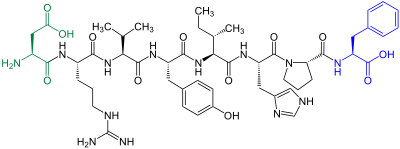Amino acid sequence
The sequence of the various amino acids in a peptide , in particular the polypeptide chain of a protein , is called the amino acid sequence , also peptide sequence or protein sequence .
The amino acid sequence provides information about which amino acids a peptide or protein is made up of and the order in which the individual amino acid components are linked to one another by peptide bonds ; it represents the primary structure of a protein.
| Amino acid sequence of angiotensin II , an octapeptide |
|---|
 Structural formula |
|
Three-letter code |
|
D R V Y I H P F
Single letter code |
Display options
The representation of the amino acid sequence of a peptide is possible in different degrees of abstraction. One variant is to represent the sequence of the amino acids using chemical structural formulas, whereby the stereochemistry can be identified.
More often, the amino acid sequence is indicated by symbols of the three-letter or one-letter code. In the three-letter code, an amino acid is represented by three letters; the peptide bonds are symbolized by connecting lines. With the one-letter code, one letter stands for the respective amino acid. Unless otherwise indicated, an L -amino acid is meant. The amino acid sequence is noted starting with the N -terminal amino acid on the left. The direction of writing from the N terminus to the C terminus corresponds to the sequence in the natural synthesis process of the proteins on the ribosomes in the course of translation .
Expression of genetic information
As part of ribosomal protein biosynthesis, all cells can gradually link selected amino acids through peptide bonds to form the chain of a specific polypeptide. The type and position of amino acids in its amino acid sequence are determined by the genetic information reproduced in the present mRNA strand: the type and position of nucleobases in its nucleotide sequence . With the help of tRNA molecules, the bases of three nucleotides - a base triplet - are read as a codon and translated into a specific amino acid, according to the genetic code . In this translation process, a specific base sequence in the mRNA corresponds to a specific amino acid sequence in the protein.
In the preceding process of transcription , the RNA strand was built up by an RNA polymerase based on the template of a certain DNA segment and its base sequence was thus rewritten into that of an RNA. The amino acid sequence of the protein formed can thus be deduced from the sequence of a DNA segment coding for proteins via the coding RNA segment. However, since several codons can stand for the same amino acid, the reverse conclusion is not clearly possible.
Basic structure of proteins
The amino acid sequence represents the primary structure of proteins. It indicates the sequence of the basic building blocks of the biopolymer : which amino acids are connected to each other in which order to form the polypeptide . These are usually α- amino acids in a linear sequence, the ends of which are designated as the carboxy or C terminus or as the amino or N terminus. Between the C -terminal and the N -terminal, α-amino acids with two carbon atoms each are integrated into the main chain via peptide bonds , while their residues form different side chains . The main chain of the polypeptide is the backbone ( the backbone ) of the protein and secures the inner covalent integrity of the macromolecule . The side chains, which vary depending on the amino acid sequence, determine higher structural levels of a protein ( secondary structure , tertiary structure , quaternary structure ) during protein folding in the cell environment .
During translation, secondary structures form on parts of the primary structure as a result of the interactions between the side chains of the amino acids. Often these take on a final form, in some cases enzymes ( called chaperones ), post-translational modifications and environmental influences (e.g. in the case of prions ) are also involved in the folding process. The spatial structure fulfillment (tertiary structure) emerges from the secondary structure and, if necessary, the complexation with other subunits to protein complexes (quaternary structure).
At present there is no reliable method to predict the exact spatial arrangement of an amino acid chain based on the primary structure . From experience, however, statements can be made about particular structural elements and about the probable functions of the protein. The amino acid sequence can be determined by protein sequencing . In the course of a protein design , the amino acid sequence can be specifically changed in order to change the properties of the protein.
Individual evidence
- ↑ Hans-Dieter Jakubke: Peptides - Chemistry and Biology. , Spektrum Akademischer Verlag GmbH , Heidelberg / Berlin / New York, 1996, ISBN 3-8274-0000-7 .
- ^ Georg Löffler, Petro Petrides, Peter Heinrich: Biochemie und Pathobiochemie , 8th edition, Springer Medizin Verlag , Heidelberg, 2007, p. 289, ISBN 978-3-540-32680-9 .

